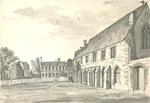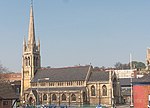St Hugh's Church, Lincoln
19th-century Roman Catholic church buildings in the United KingdomChurches in Lincoln, EnglandGothic Revival architecture in LincolnshireGothic Revival church buildings in EnglandGrade II listed Roman Catholic churches in England ... and 3 more
Grade II listed churches in LincolnshireRoman Catholic churches completed in 1893Roman Catholic churches in Lincolnshire

St Hugh's Church or St Hugh of Lincoln Church is a Roman Catholic Parish church in Lincoln, England. It was built from 1892 to 1893. It is situated on the corner of Monks Road and Friars Lane in the city centre. It was designed by Albert Vicars and is a Grade II listed building.
Excerpt from the Wikipedia article St Hugh's Church, Lincoln (License: CC BY-SA 3.0, Authors, Images).St Hugh's Church, Lincoln
Monks Road, Lincoln New Boultham
Geographical coordinates (GPS) Address External links Nearby Places Show on map
Geographical coordinates (GPS)
| Latitude | Longitude |
|---|---|
| N 53.2305 ° | E -0.5357 ° |
Address
Saint Hugh of Lincoln
Monks Road
LN2 5HW Lincoln, New Boultham
England, United Kingdom
Open on Google Maps









